Alignment & Posture (Upd: Jan 23, ’22)
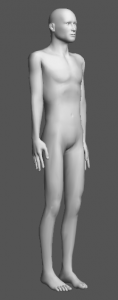
“Keeping his body in a straight posture, holding the chest, neck and the head erect, and drawing the senses and the mind into the heart, the wise should cross over the fearful currents of the world by means of the raft (or boat) of Brahman.” – Svetasvatara Upanishad¹
Though butoh is generally about breaking form and context, it is advisable to have one place to use as a starting ground for rebellion assuming the practice is sustainable. I believe in developing a sustainable butoh so that the butoh we practice today can be practiced all the way to old age with minimal loss of physical range. If we are privileged in being an abled human, we are constantly inundated with standing, walking, and pacing.
Here I will draw out a neutral alignment (shadowbody version) that will be used as a launching ground for further movement. Not everybody’s spinal structure will be able to align comfortably with the below instructions. Becoming aware of your body’s place in alignment is the beginning of discovering a more neutral and effortless lifestyle.
1. Top & Bottom String
Feel a string both at the top of your head pulling up and at your perineum pulling down. Like in architecture, when these strings are attached, the strings will give the body tension and the pull of gravity will give the body compression. Feel both. The combination makes a subtle spring.
2. Feet
Find three equal points of balance between heel, and two points on the mounds right under the toes.
3. Ankles
Soften the ankles. Leave space for a little give.
4. Knees
Soften the knees. Knees should also always be in a slight bend of some sort even outside of butoh practice. Unless one is redistributing tension to the quadriceps, I would suggest always keeping a bend at the knees. Indigenous people who have a tendency to not have knee issues always keep their knees bent.
5. Hips
Soften the hips. Like the knees, allow for a slight bend. Leave space for a little give.
6. Pelvis
Slightly engage lower abdomen, near the point of the symphysis pubis. Have awareness of the Dan tien 3 inches below the naval.
7. Spine
The indigenous J-shape spine where the Sacral-Coccyx is curved out (butt sticking out) and remainder of spine effortlessly stacked and aligned is my preferred neutral spine alignment as opposed to the modern dance/ballet alignment where the Sacral-Coccyx is tucked in slightly to achieve more of a stacked spine throughout. Like with the knees, indigenous people use a J-shape spine and they also do not have associations with back problems.
To get a feeling for what this type of spinal alignment feels like, simply sit down and pull on your butt cheeks. Then just stack and relax the remainder of the spine. Feel this same alignment while standing. It allows for longer periods of standing and sitting.
8. Chest
The chest should not be caved in but not puffed out too much either. Think open but humble. To get a feel of the natural placement of the chest, massage the muscles beside the sternum and also the muscles right under both the distal and proximal end of the clavicle. Then shrug the shoulder up then back and massage again. Repeat with other shoulder. This will cause your fascia to naturally respond to a neutral yet open chest.
9. Shoulders
Roll the shoulders up and over behind you for several rotations then completely relax the tension at a stopping point behind you. Your shoulders should rest at along the coronal line of the body, which should place your middle finger at the same coronal line.
10. Neck
Initiate forward and back movements with the neck. You can imagine your chin engaging the movement. End back and then relax your neck. You should find that your ear canal will be at the coronal line of the body.
11. Skull
Rotate just the skull down and up several times. Just the skull, not the whole c-spine. When the skull comes down, feel the base of the skull slightly engaged. Feel as if this is an anchor point so that your head does not bobble like a bobble head. It is with the anchoring of this position that people can balance items on the central point at the top of the head. Relax face, and especially eyes and mouth. Best to keep lips slightly open as a reminder to relax the whole face. Also this neutral position is humble yet centered. When the head is titled up, there are often associations with ego.
Note: Once, we get this position down, it will then be important to break it. We can draw from any position and posture for butoh or body-based life resonance. Borrow and/or deviate from any posture or positions from yoga, external and internal martial arts, ballet, jazz, contemporary, mime, physical theatre, sports, calisthenics, parkour, gymnastics, animals, trees, and landscapes.
Center of Gravity
When standing erect in a neutral position, the center of gravity can be thought of as residing at the Dan Tien or just below the belly button. However, it is good to shift this center of gravity depending on our body posture and intention. For instance, if we can drop the center of gravity to somewhere in the legs if we want to have a drooping effect of the upper body.
Butoh Postures?
In Waguri’s CD-Rom,² Waguri went over some very specific postures from Tatsumi Hijikata’s butoh-fu. Early butoh had a very formalist agenda to it, but it generally does not seem to be practiced that way today. Regardless, Adam Koan (author of this manual) is starting to document personal postures that resonate heavily. So far here are three of such postures which are best done in keeping the principles of Noguchi taiso.
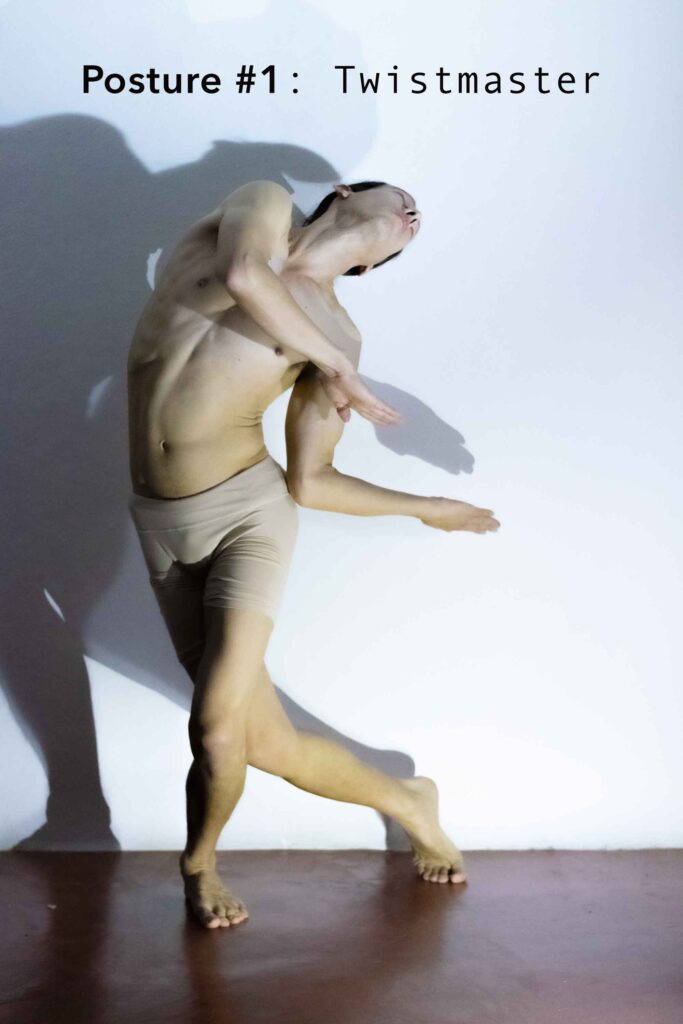
Posture #1: Twistmaster
1. The legs begin rotating one direction which will results in crossed/twisted legs.
2. The twist continues with the remainder of the body in the same direction. The spine goes the same direction as the legs, arms, and head. Even the pupils rotate in the same direction as well as the rest of the face.
3. Once the maximum amount of twist is discovered with the entire body and limbs (be gentle, know your limits), stylize accordingly, e.g. extension, contraction.
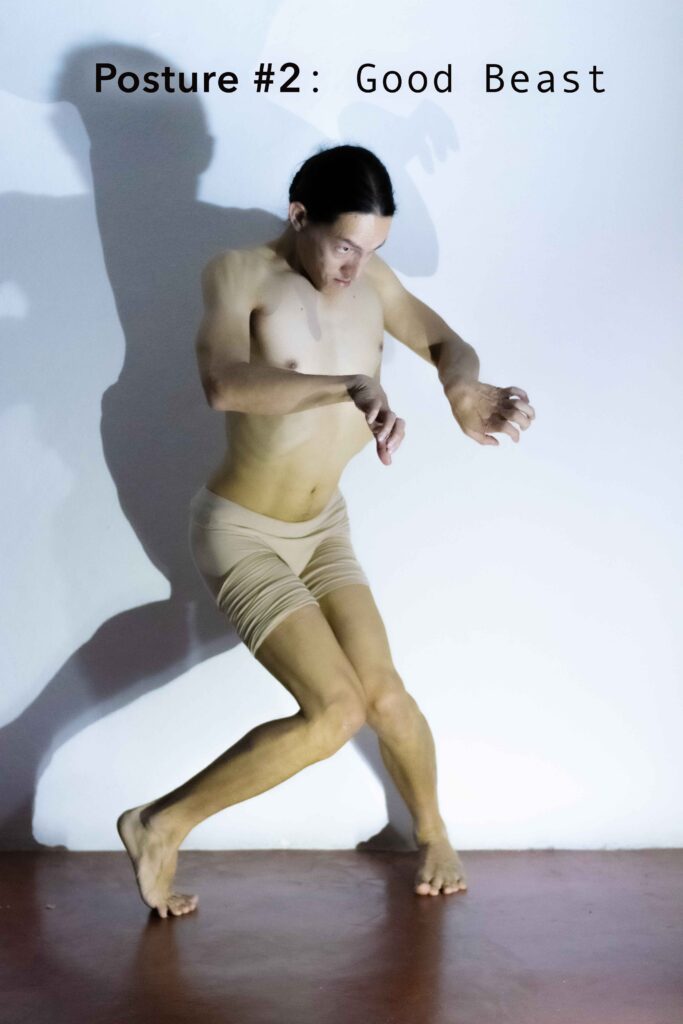
Posture #2: Good Beast
1. The legs begin turning in so that the knees touch.
2. The tail extends which is the sacrum/coccyx (in other words, the butt sticks out).
3. The chest overextends proudly.
4. The arms rotate from the shoulders (better yet, from the sternoclavicular joint articulation). If a shrug naturally occurs, let it happen.
5. The wrists flex down (like the direction of limp wrist).
a. The carpometacarpal joints (knuckle joints) extend.
b. Both proximal and distal interphalangeal joints (middle and end finger joints) contract. The thumb is not forgotten.
6. The c-spine is protracted up and over to the front (the face pushes forward) followed by the neck flexing down (trying to face down).
7. Pupils look up to the front of you.
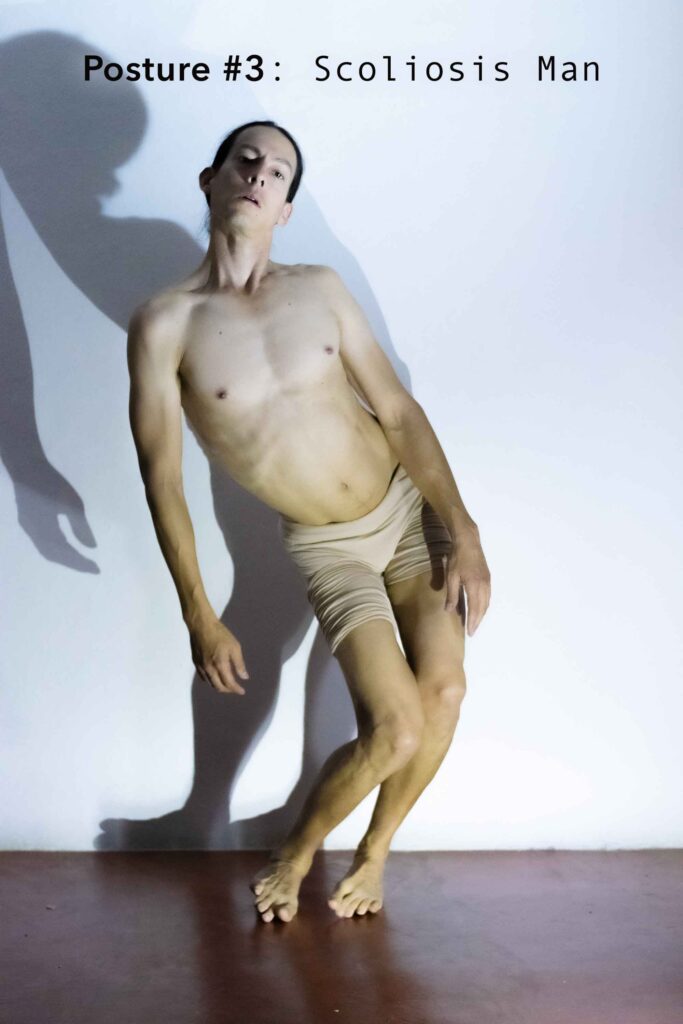
Posture #3: Scoliosis Man
1. The feet tilt to one side, balancing the body on the ridges of the feet.
2. The knees soften/plie and are allowed to tilt in the same direction
3. The hip is opened and is allowed to continue the tilt/curve
4. The l-spine (lower back) continues the tilt/curve
5. The t-spine (thorax) breaks the direction of the curve
6. The head follows the direction of the t-spine.
7. Arms dangle relaxed
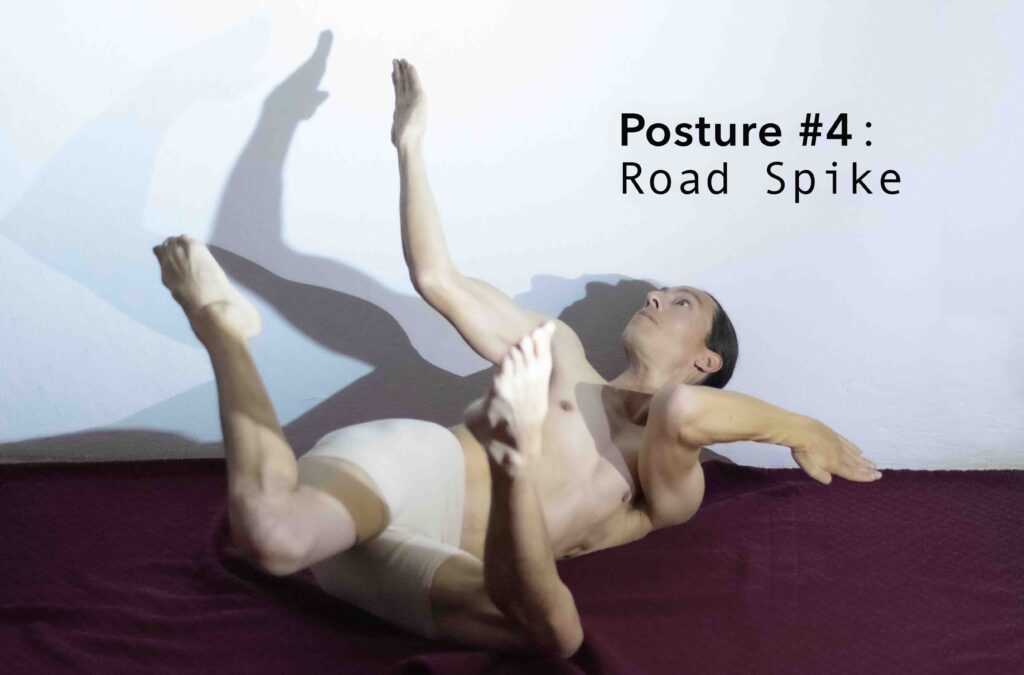
Posture #4: Road Spike
This posture embraces the qualia/spirit of the road spike, so the whole body is resonating with sharpness and pointness.
1. Rotate both legs from the hip in one direction. Bend knees to point your feet up.
2. Arms rotate away from each other from the shoulder joint (or even better, the sternoclavicular joint). Both hands and elbows can feel the sharp points.
3. The head, eyes, nose, chin are also sharp points.